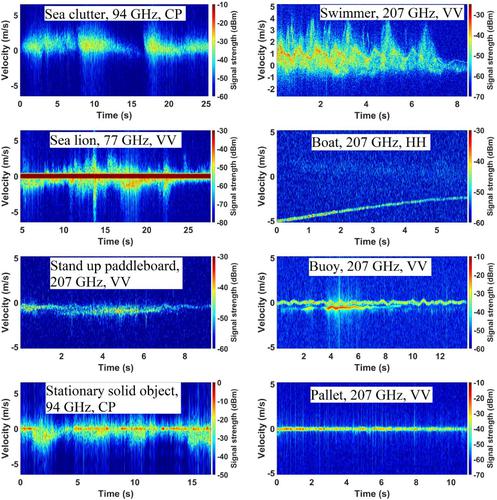当前位置:
X-MOL 学术
›
IET Radar Sonar Navig.
›
论文详情
Our official English website, www.x-mol.net, welcomes your feedback! (Note: you will need to create a separate account there.)
Machine learning-based approach for maritime target classification and anomaly detection using millimetre wave radar Doppler signatures
IET Radar Sonar and Navigation ( IF 1.7 ) Pub Date : 2023-12-06 , DOI: 10.1049/rsn2.12518 Samiur Rahman 1 , Aleksanteri B. Vattulainen 1 , Duncan A. Robertson 1
IET Radar Sonar and Navigation ( IF 1.7 ) Pub Date : 2023-12-06 , DOI: 10.1049/rsn2.12518 Samiur Rahman 1 , Aleksanteri B. Vattulainen 1 , Duncan A. Robertson 1
Affiliation

|
The authors present multiple machine learning-based methods for distinguishing maritime targets from sea clutter. The main goal for this classification framework is to aid future millimetre wave radar system design for marine autonomy. Availability of empirical data at this frequency range in the literature is scarce. The classification and anomaly detection techniques reported here use experimental data collected from three different field trials from three different millimetre wave radars. Two W-band radars operating at 77 and 94 GHz and a G-band radar operating at 207 GHz were used for the field trial data collection. The dataset encompasses eight classes including sea clutter returns. The other targets are boat, stand up paddleboard/kayak, swimmer, buoy, pallet, stationary solid object (i.e. rock) and sea lion. The Doppler signatures of the targets have been investigated to generate feature values. Five feature values have been extracted from Doppler spectra and four feature values from Doppler spectrograms. The features were trained on a supervised learning model for classification as well as an unsupervised model for anomaly detection. The supervised learning was performed for both multi-class and 2-class (sea clutter and target) classification. The classification based on spectrum features provided an 84.3% and 80.1% validation and test accuracy respectively for the multi-class classification. For the spectrogram feature-based learning, the validation and test accuracy for multi-class increased to 93.3% and 88.7% respectively. For the 2-class classification, the spectrum feature-based training accuracies are 88.1% and 86.8%, whereas with the spectrogram feature-based model, the values are 95% and 94.1% for validation and test accuracies respectively. A one class support vector machine was also applied to an unlabelled dataset for anomaly detection training, with 10% outlier data. The cross-validation accuracy has shown very good agreement with the expected anomaly detection rate.
中文翻译:

基于机器学习的方法,使用毫米波雷达多普勒特征进行海上目标分类和异常检测
作者提出了多种基于机器学习的方法来区分海上目标和海杂波。该分类框架的主要目标是帮助未来用于海洋自主的毫米波雷达系统设计。文献中该频率范围的经验数据很少。这里报告的分类和异常检测技术使用从三个不同毫米波雷达的三个不同现场试验中收集的实验数据。现场试验数据收集使用了两个工作频率为 77 和 94 GHz 的 W 波段雷达以及一个工作频率为 207 GHz 的 G 波段雷达。该数据集包含八个类别,包括海杂波返回。其他目标是船、立式桨板/皮划艇、游泳者、浮标、托盘、固定固体物体(即岩石)和海狮。已经研究了目标的多普勒特征以生成特征值。从多普勒频谱中提取了五个特征值,从多普勒频谱图中提取了四个特征值。这些特征在用于分类的监督学习模型和用于异常检测的无监督模型上进行训练。监督学习针对多类和 2 类(海杂波和目标)分类进行。基于频谱特征的分类为多类分类提供了 84.3% 和 80.1% 的验证准确率和测试准确率。对于基于频谱图特征的学习,多类的验证和测试准确率分别提高到 93.3% 和 88.7%。对于二类分类,基于频谱特征的训练精度为 88.1% 和 86.8%,而对于基于频谱图特征的模型,验证和测试精度的值分别为 95% 和 94.1%。一类支持向量机也被应用于未标记的数据集以进行异常检测训练,其中包含 10% 的异常数据。交叉验证的准确性与预期的异常检测率非常吻合。
更新日期:2023-12-06
中文翻译:

基于机器学习的方法,使用毫米波雷达多普勒特征进行海上目标分类和异常检测
作者提出了多种基于机器学习的方法来区分海上目标和海杂波。该分类框架的主要目标是帮助未来用于海洋自主的毫米波雷达系统设计。文献中该频率范围的经验数据很少。这里报告的分类和异常检测技术使用从三个不同毫米波雷达的三个不同现场试验中收集的实验数据。现场试验数据收集使用了两个工作频率为 77 和 94 GHz 的 W 波段雷达以及一个工作频率为 207 GHz 的 G 波段雷达。该数据集包含八个类别,包括海杂波返回。其他目标是船、立式桨板/皮划艇、游泳者、浮标、托盘、固定固体物体(即岩石)和海狮。已经研究了目标的多普勒特征以生成特征值。从多普勒频谱中提取了五个特征值,从多普勒频谱图中提取了四个特征值。这些特征在用于分类的监督学习模型和用于异常检测的无监督模型上进行训练。监督学习针对多类和 2 类(海杂波和目标)分类进行。基于频谱特征的分类为多类分类提供了 84.3% 和 80.1% 的验证准确率和测试准确率。对于基于频谱图特征的学习,多类的验证和测试准确率分别提高到 93.3% 和 88.7%。对于二类分类,基于频谱特征的训练精度为 88.1% 和 86.8%,而对于基于频谱图特征的模型,验证和测试精度的值分别为 95% 和 94.1%。一类支持向量机也被应用于未标记的数据集以进行异常检测训练,其中包含 10% 的异常数据。交叉验证的准确性与预期的异常检测率非常吻合。



























 京公网安备 11010802027423号
京公网安备 11010802027423号